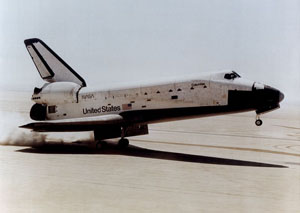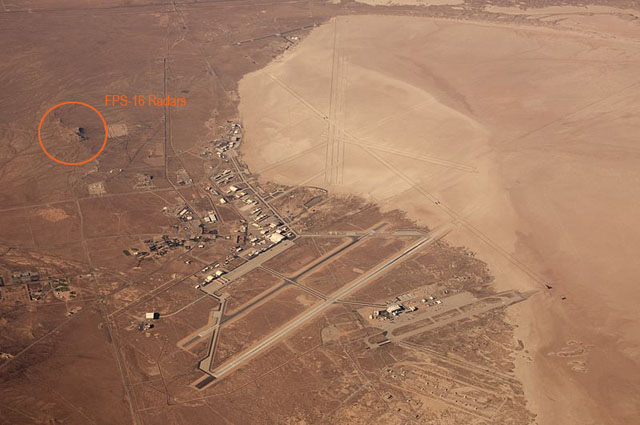As we prepare for America’s very last shuttle mission, I thought I would share the story of my small role in the first shuttle space mission, STS-1. (No, I didn’t get the word order wrong. There were previous shuttle missions piggybacked on a modified 747 that did not go into space.) Anyway, be warned. This post is a little long.
In 1980, I arrived as an engineer at Edwards Air Force Base, working for Kentron International, the engineering services contractor for the base. In college, I had wanted to study computer science, but at the time, almost no schools offered a degree in computer science. I ended up studying electrical engineering with a computer science “area of specialization”.
In my interview for the job at Edwards, I talked about programming microprocessors, a skill I was sure they would be interested in. The guy I interviewed with did not see things quite the same way. It turned out they did almost no microprocessor work, doing most of their designs as large circuit boards covered with hundreds of logic chips. The guy explained to me that microprocessors were a “fad”, which would quickly pass. (!) I got the job because I convinced him I could do circuit design as well.
About the time I finished my first microprocessor-based project for them (I never did any circuit design there), Edwards got the news that a large system they had ordered years before would be a year or two late in arriving. This news caused more than a little panic, because the system was required for them to participate in the orbital portion of space shuttle missions. Sure, the shuttle would still land at Edwards, but if they lost the orbital portion, it was not only humiliating; they also would lose a substantial amount of funds, much of which they had already spent preparing for the shuttle landing. And they were rightly very proud of the accuracy of their two RCA AN/FPS-16 radars (16-foot diameter dishes) made during the golden age of radar in the early 1960s. They calibrated these radars by bouncing a signal off the surface of the moon.
Previous space missions had been done “unplugged”, at least the tracking part. Each site that did tracking of the spacecraft would watch the horizon at the point the spacecraft was expected to appear, and when it was supposed pop into view, the radar operators would madly search to find it. When they found it, they would lock on with the radar, and it was automatic from that point. The tracking data was recorded on a tape drive, and it was processed later.
This was to be the first space mission to use “continuous track”. Live data would be sent over phone lines from a site tracking the shuttle to the next site it would pass over, and that site would slave their radars to the data to locate the shuttle before locking on. That site would then send live data to the next site, and so on, providing continuous tracking data. All the live data also went back to Houston so they could immediately see where the shuttle was. The system that was going to be late did the slaving and data transmission that allowed them to do continuous track, as well as lots of other stuff. They could do without the other stuff, but they needed the slaving and data transmission.
There was a very short time available to create a replacement. In order to participate in the shuttle mission, a site had to succeed in a test of the continuous track system. The test was to track a dead satellite continuously around the world, and the test was scheduled about 90 days after Edwards found out the system was going to be late. My fellow engineers, who designed with logic chips, estimated they could do a replacement in nine months or so.
Being young and foolish, I spoke up and suggested a way we could do it in the time allotted. There was an off-the-shelf computer system intended for industrial applications that could meet the requirements. There were plug-in circuit boards from several vendors to do the different things we needed. The other engineers were smart enough to understand that if someone failed at this task, he would almost certainly be fired because of the political weight of the issue. I was naiive about the politics, and there was a consensus in our group that I should be the one to get the assignment.
I ordered the parts, put them together, wrote some assembly language code and started doing tests. Everything worked, except sending and receiving data across the phone line. We used an unusual mode of data transmission (synchronous, rather than the normal asynchronous), but I couldn’t get it to work no matter what I did. As I countinued to beat on it without success, everyone got more and more nervous.
After a couple of weeks of this, my boss hired a consultant to come in and help me. They did want him to get it up and running, but they also wanted him to tell them whether they should fire me right away.
The consultant and I got along well, and he eventually identified the problem in a place I had not thought to look. It turned out that the plug-in board I bought to do the data transmission had a design flaw that made it work fine for asynchronous data, but not work for synchronous. I cut a few traces on the circuit board with an X-acto knife and soldered on a few wires to correct the problem, and everything was running just as it should. The consultant gave a very positive report on me, and later tried to hire me.
Edwards participated in the test with the dead satellite, with me at the radar all night as the test continued, “just in case”. A couple of sites failed the test (not Edwards), and they did another test a week or two later, again with me standing by in the radar all night.
About ten days before the shuttle landed in April of 1981, my boss told me I needed to attend the base commander’s staff meeting. Once again, being young and foolish, I thought maybe the commander would thank me for all the all-nighters I put in to get the project done. For the entire staff meeting (an hour and a half) no one even glanced at me. When the meeting was over, the commander peered at me and asked, “You Gloster?” I nodded. He said, “I need you to be at the radar for the whole shuttle mission, understand?” I wasn’t quite sure what to say, so I nodded. He said, “That is all”, picked up his notes and walked out of the conference room.
When I got back to the office, I asked my boss, “He can’t really do that can he? I’m a civilian, not an airman, and not even a civil servant.” My boss said, “Don’t make an issue out of it. Just do it. I’ll give you some comp time later.”
So, as America watched Cape Kennedy prepare for the launch, I was holed up in the tiny cinderblock building that housed one of the FPS-16 radars, where I remained for three days with my sleeping bag, as radar operators went in and out for their shifts. Nothing went wrong. If it had, I had a spare unit I had built, but I’m not sure I could have done anything other than swapping the unit out.
Two days later, when the shuttle landed, I was a little bleary. Sleeping a couple of nights on a concrete floor behind humming racks of equipment while you are excited and a little worried doesn’t really give you quality rest. But the radars are on a hill overlooking the lakebed, and watching the landing from there gave me the best view of anyone. Getting the best seat in the house for that historic event made all the project’s late nights, political undercurrents and difficulties worth it.


